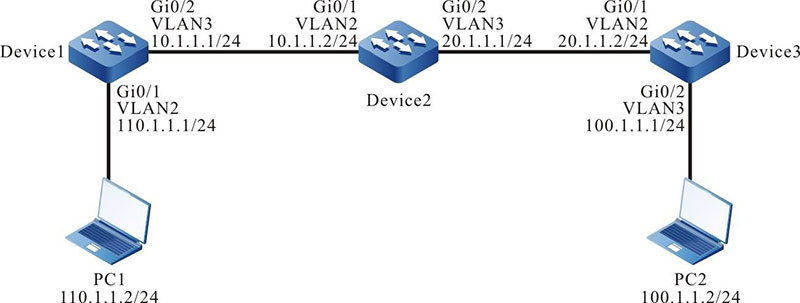Network Requirement
- On Device1, Device2 and Device3, configure static routes so that PC1 and PC2 can communicate with each other.
Network Topology

Figure 3-1 Networking for Configure Static Routing Basic Functions
Configuration Steps
Step 1: Create VLANs, and add ports to the required VLANs. (Omitted)
Step 2: Configure IP addresses for the ports. (Omitted)
Step 3: Configure static routes.
#Configure Device1.
|
Device1#configure terminal
Device1(config)#ip route 20.1.1.0 255.255.255.0 10.1.1.2
Device1(config)#ip route 100.1.1.0 255.255.255.0 10.1.1.2
|
#Configure Device2.
|
Device2#configure terminal
Device2(config)#ip route 110.1.1.0 255.255.255.0 10.1.1.1
Device2(config)#ip route 100.1.1.0 255.255.255.0 20.1.1.2
|
#Configure Device3.
|
Device3#configure terminal
Device3(config)#ip route 0.0.0.0 0.0.0.0 20.1.1.1
|
#Query the routing table of Device1.
Device1#show ip route
Codes: C - connected, S - static, R - RIP, O - OSPF, OE-OSPF External, M - Management
D - Redirect, E - IRMP, EX - IRMP external, o - SNSP, B - BGP, i-ISIS
Gateway of last resort is not set
C 10.1.1.0/24 is directly connected, 00:06:47, vlan3
S 20.1.1.0/24 [1/100] via 10.1.1.2, 00:00:13, vlan3
S 100.1.1.0/24 [1/100] via 10.1.1.2, 00:00:05, vlan3
C 110.1.1.0/24 is directly connected, 00:08:21, vlan2
C 127.0.0.0/8 is directly connected, 28:48:33, lo0
#Query the routing table of Device2.
Device2#show ip route
Codes: C - connected, S - static, R - RIP, O - OSPF, OE-OSPF External, M Management
D - Redirect, E - IRMP, EX - IRMP external, o - SNSP, B BGP, i-ISIS
Gateway of last resort is not set
C 10.1.1.0/24 is directly connected, 00:00:37, vlan2
C 20.1.1.0/24 is directly connected, 00:00:27, vlan3
S 100.1.1.0/24 [1/100] via 20.1.1.2, 00:00:05, vlan3
S 110.1.1.0/24 [1/100] via 10.1.1.1, 00:00:13, vlan2
C 127.0.0.0/8 is directly connected, 30:13:18, lo0
Query the routing table of Device3.
Device3#show ip route
Codes: C - connected, S - static, R - RIP, O - OSPF, OE-OSPF External, M Management
D - Redirect, E - IRMP, EX - IRMP external, o - SNSP, B BGP, i-ISIS
Gateway of last resort is 20.1.1.2 to network 0.0.0.0
S 0.0.0.0/0 [1/100] via 20.1.1.1, 00:00:07, vlan2
C 20.1.1.0/24 is directly connected, 00:00:08, vlan2
C 100.1.1.0/24 is directly connected, 00:00:13, vlan3
C 127.0.0.0/8 is directly connected, 29:17:19, lo0
Step 4: Check the result. Use the ping command to verify the connectivity between PC1 and PC2
#On PC1, use the ping command to check the connectivity.
C:\Documents and Settings\Administrator>ping 100.1.1.2
Pinging 100.1.1.2 with 32 bytes of data:
Reply from 100.1.1.2: bytes=32 time<1ms TTL=125
Reply from 100.1.1.2: bytes=32 time<1ms TTL=125
Reply from 100.1.1.2: bytes=32 time<1ms TTL=125
Reply from 100.1.1.2: bytes=32 time<1ms TTL=125
Ping statistics for 100.1.1.2:
Packets: Sent = 4, Received = 4, Lost = 0 (0% loss), Approximate round trip times in milli-seconds:
Minimum = 0ms, Maximum = 0ms, Average = 0ms
PC1 and PC2 can communicate with each other.
 Switch
Switch Wifi - Access Point
Wifi - Access Point Firewall
Firewall Router
Router Module Quang
Module Quang![Module Quang Cisco]() Module Quang Cisco
Module Quang Cisco![Module quang HPE]() Module quang HPE
Module quang HPE![Module quang Maipu]() Module quang Maipu
Module quang Maipu![Module quang Brocade]() Module quang Brocade
Module quang Brocade![Module quang Fortinet]() Module quang Fortinet
Module quang Fortinet![Module quang Aruba]() Module quang Aruba
Module quang Aruba![Module quang OEM]() Module quang OEM
Module quang OEM![Module quang Juniper]() Module quang Juniper
Module quang Juniper![Module quang Dell]() Module quang Dell
Module quang Dell![Module quang Palo Alto]() Module quang Palo Alto
Module quang Palo Alto![Module quang Huawei]() Module quang Huawei
Module quang Huawei![Module quang Arista]() Module quang Arista
Module quang Arista![Module quang F5]() Module quang F5
Module quang F5![Module quang H3C]() Module quang H3C
Module quang H3C![Module Quang Allied Telesis]() Module Quang Allied Telesis
Module Quang Allied Telesis![Module quang SonicWall]() Module quang SonicWall
Module quang SonicWall![Module quang Mikrotik]() Module quang Mikrotik
Module quang Mikrotik![Module quang Handar]() Module quang Handar
Module quang Handar Máy chủ (Server)
Máy chủ (Server) Thiết bị lưu trữ (SAN, NAS)
Thiết bị lưu trữ (SAN, NAS) Load Balancing
Load Balancing Video Conferencing
Video Conferencing Phụ kiện máy chủ
Phụ kiện máy chủ Thiết Bị IoT
Thiết Bị IoT Phụ Kiện Mạng
Phụ Kiện Mạng




.png)
























